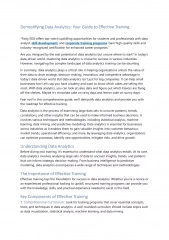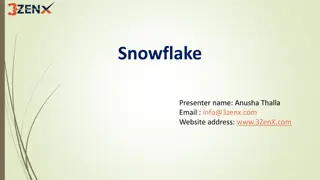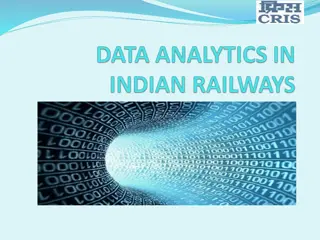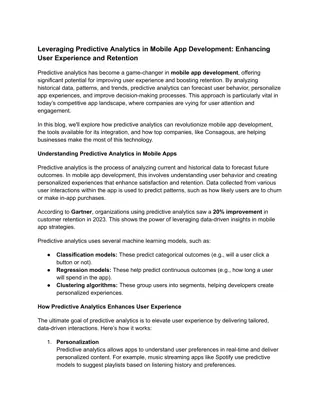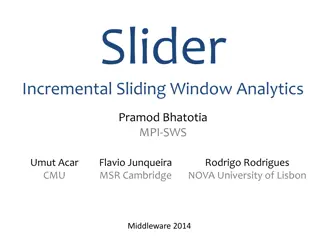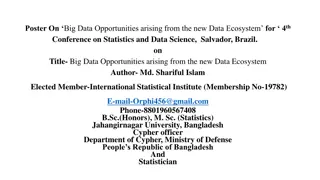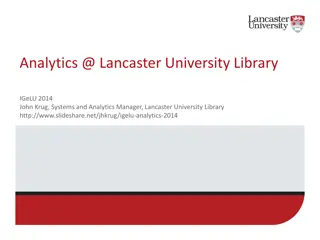SciDB: Revolutionizing Data Management for Scientific Analytics
SciDB is an open-source analytical database designed to meet the complex data management needs of the scientific community. It offers a unique array-based data model that supports advanced linear algebra operations crucial for scientific analytics. By addressing the limitations of traditional relational database management systems (RDBMS), SciDB provides a robust solution for handling large-scale scientific data effectively.
Download Presentation

Please find below an Image/Link to download the presentation.
The content on the website is provided AS IS for your information and personal use only. It may not be sold, licensed, or shared on other websites without obtaining consent from the author. Download presentation by click this link. If you encounter any issues during the download, it is possible that the publisher has removed the file from their server.
E N D
Presentation Transcript
CS239-Lecture 9 Array Processing Madan Musuvathi Visiting Professor, UCLA Principal Researcher, Microsoft Research
Mid-point feedback Are you learning from the papers we are reading? Do you find class discussions helpful? Does preparing for the class presentation help? What would you change moving forward?
Architecture and Demonstration of SciDB Tian Yu
What is SciDB LSST(Large Synoptic Survey Telescope) is the next big science astronomy project. They realized current DB can not handle more and more data in 2007. RDBMS: wrong data model, wrong operators, missing required capabilities. Why can t somebody do for science what RDBMS did for business??? SciDB SciDB is an open-source analytical database oriented toward the data management needs of scientists. It mixes statistical and linear algebra operations with data management ones, using a natural nested multi- dimensional array data model.
SciDB vs RDBMS SciDB Shared-nothing Array Support In Situ data Overlapping between chunks Support Support Support No RDBMS Shared-nothing Table Must load data into system No overlapping Not support Not support Not support Yes schema Data model Overhead of loading data storage provenance uncertainty Version Built-in operators
Array Data Model Arrays can have any number of named dimensions. Dimension can be traditional integer, non-integer or even user-defined data type. To facilitate queries, non-integer dimensions are stored as integer mapping index. Each dimension either has starting and ending points, or be unbounded. Why using array rather than table? Most complex analytics the science community uses are based on core linear algebra operations.
ArrayData Model (contd) Each combination of dimension values defines a cell of array. Allow nested array data model and support hierarchical decomposition of cells. Every cell in a given array has same data types for its values including scalars and arrays. How to specify an array in SciDB? CREATE ARRAY example<M: int, N: float> [I=1:1000, J=1000:2000] //creating an array with attributes M and N along with dimensions I and J.
Storage of Arrays Chunk arrays into blocks using some (or even all) of the dimensions with certain stride. Each is stored in a container(file) on disk. fixed logical size but different physical size or fixed physical size? Easily join(frequent ) Fixed logical size Fixed physical size advantages Simple addressing schema Enable simple main memory buffer pool disadvantages Complex main memory buffer pool Extra indexing scheme like R-tree to track chunk definitions In some cases, CPU time can be economized by splitting chunk internally into tiles. Compression system optionally elect to tile the chunk. To facilitate neighborhood queries, chunks in SciDB should overlap by a specific amount in each of several dimensions, which is the size of the largest feature that will be searched for. SciDB allows the partitioning to change over time: e.g., a first partitioning scheme is used for time less than T and second one for time greater then T.
Storage of Arrays(example) Suppose we want to find areas of imagery with larger sensor amplitude than neighboring area. In RDBMS, some calculation of the chunk requires data of other chunks. This query is not embarrassingly parallel In SciDB, to facilitate such neighborhood queries, the chunks can be specified to overlap by a specific amount in each of several dimensions. Parallel feature extraction can occur without requiring any data movement If insufficient overlap is present, SciDB reshuffles data to generate required overlap.
Query operator and Language No built-in operators! Why and How? Structural operators: subsample, cross product, concatenate, remove dimension Content-dependent operators: filter, update Both structural and content-dependent operators: join AQL(SQL-like language) is compiled into AFL(functional language)
Query Language and operator(Join) 1. Equi-dimensional joins: Two dimensions: I and J 2. Non equi-dimensional joins: Three dimensions: I from A, I from B and J 3. Attribute joins: In the case of a Join on an m-dimensional array and an n-dimensional array that involves only k index attributes from each of the arrays in the join predicate, the result will be an (m+n-2k)-dimensional array with concatenated cell tuples wherever the predicate is true. Four dimensions: I from A, I from B J from A and J from B
Query Language and operator Bulk changes to dimensions, e.g. push all dimension values up one to make a slot for new data; Flip dimensions for attributes, e.g. replace dimension I in array A with a dimension made up from d. Transform one or more dimension, e.g. change I and J into polar co- ordinates. Increment a value for a specific cell
Query Processing Three guiding principles of query processing in SciDB: 1. Aim for parallelism in all operations with as little data movement as possible. 2. Incremental optimizers have more accurate size information and use this to construct better query plans 3. Use a cost-based optimizer. the cheaper commuting operation down the tree(e.g., filter first, then join) If an operation cannot be run in parallel because of poorly distribution, SciBD will reshuffle it. is beneficial for picking next sub-tree Examines operations that commute, and push Tenet 2: result size information Until no more { Choose and optimize next sub-plan Reshuffle data, if required Execute a sub-plan in parallel on a collection of local nodes Collect size information from each local node }
Version Control Scientists never want to throw away old data, whether wrong or not. One important reason is cooking of raw data into derived information. All SciDB arrays are versioned. Query processing refers to certain version data according to timestamp and version number. Clearly, one wants to support versions without paying the cost of a copy for unchanged data. Versions are stored as a delta off their parents. The physical organization of each chunk contains a reserved area to maintain the delta chain. Keep the most up-to-date version chunks stored contiguously. SciDB preserves raw data, so different scientists can cook and recook different dishes using the same raw material . For example, using different feature extraction algorithm on the same image for different purposes.
Skew Management It is advantageous to move data from disk to main memory in fixed size blocks. Recall that our chunk is not physical size fixed (because of update traffic and density of non-null data skew). How to solve the problem? SciDB s main memory buffer pool is composed of a collection of fixed size slots containing worthy fixed size blocks (e.g.: B bytes): If a chunk is too large, cycling through the chunking dimensions, splitting each in turn. SciDB supports arbitrary number of splits to keep chunk size below B. If a chunk is too small, because it is sparsely populated with data, it can accommodate many updates before it fills or be co-located with neighboring sparse chunks.
Compression Different data has different optimal compression method. SciDB s compression system examines a chunk, and then chooses the appropriate compression scheme on a chunk-by-chunk basis. If we only need several tiles within one chunk, SciDB can only decompress and recompress tiles. The compression engine controls the splitting and packing of chunks. Decide chunks or tiles needed Load into main memory Split and pack encoding
Provenance OMG!! Some data looks wrong NO Problem!! SciDB records a log of the commands that were run to create D: For a given data element D, trace backward to find the collection of processing steps that created it from input data. For a given data element D, trace forward to find all the downstream data elements whose value is impacted by the value of D. Provenance for arrays or cells? The solution is specifying the amount of space willing to allocate for provenance data by varying the granularity of provenance information.
Other features support uncertainty: essentially all scientific data is imprecise and calls for uncertainty. SciDB requires two values for any data element (value and error). In-situ data: can use some SciDB s capabilities without going through the effort of loading data. Approach: define a self-describing data format and then write adaptors to various popular external formats. If an adaptor exists for the user's data or if he is willing to put it in the SciDB format above, then he can use SciDB without a load stage.
Thank You Tian Yu
Decoupling Algorithms from Schedules for Easy Optimization of Image Processing Pipelines Authors: J. Ragan-Kelley, A. Adams, S. Paris, M. Levoy, S. Amarasinghe, F. Durand Speaker: Ryan Hsu
Contents Motivation Introduction Representation Implementation Evaluation Conclusion Ragan-Kelley et al., "Decoupling Algorithms from Schedules for Easy Optimization of Image Processing Pipelines" 2 1
Motivation - Example (Clean C++) Ragan-Kelley et al., "Decoupling Algorithms from Schedules for Easy Optimization of Image Processing Pipelines" 22
Example (Fast C++) Ragan-Kelley et al., "Decoupling Algorithms from Schedules for Easy Optimization of Image Processing Pipelines" 23
Example (Halide) Ragan-Kelley et al., "Decoupling Algorithms from Schedules for Easy Optimization of Image Processing Pipelines (2012) 24
Introduction Solution: algorithm separated from schedule Algorithm: about what is computed Functional: objs treated as funcs Schedule: about when and where resources should be executed Caller-callee relationships Ragan-Kelley et al., "Decoupling Algorithms from Schedules for Easy Optimization of Image Processing Pipelines" 25
Relationship 1 Inline Ragan-Kelley et al., "Decoupling Algorithms from Schedules for Easy Optimization of Image Processing Pipelines (2012) 26
Relationship 2 Root Ragan-Kelley et al., "Decoupling Algorithms from Schedules for Easy Optimization of Image Processing Pipelines (2012) 27
Relationship 3 Chunk Ragan-Kelley et al., "Decoupling Algorithms from Schedules for Easy Optimization of Image Processing Pipelines (2012) 28
Relationship 4 Reuse Ragan-Kelley et al., "Decoupling Algorithms from Schedules for Easy Optimization of Image Processing Pipelines (2012) 29
Specifying a Schedule A desired partial schedule is specified after an algorithm is described Many schedules need lots of transformation of code in C Schedules can be made tersely and return refs to funcs so that they can be chained Ragan-Kelley et al., "Decoupling Algorithms from Schedules for Easy Optimization of Image Processing Pipelines (2012) 30
Compiler Implementation Ragan-Kelley et al., "Decoupling Algorithms from Schedules for Easy Optimization of Image Processing Pipelines (2012) 31
Application 1 Camera Pipeline Ragan-Kelley et al., "Decoupling Algorithms from Schedules for Easy Optimization of Image Processing Pipelines (2012) 32
Application 2 Local Laplacian Filters Ragan-Kelley et al., "Decoupling Algorithms from Schedules for Easy Optimization of Image Processing Pipelines (2012) 33
Application 3 The Bilateral Grid Ragan-Kelley et al., "Decoupling Algorithms from Schedules for Easy Optimization of Image Processing Pipelines (2012) 34
Application 4 Image Segmentation Ragan-Kelley et al., "Decoupling Algorithms from Schedules for Easy Optimization of Image Processing Pipelines (2012) 35
Discussion Compact and efficient Lazy evaluation of functional language Needless to think the transition between states Not enough to include non-image data structures Ragan-Kelley et al., "Decoupling Algorithms from Schedules for Easy Optimization of Image Processing Pipelines (2012) 36
Conclusion Efficiency and speed matter in image processing pipelines Decoupling algorithm from schedule benefits Future language should utilize compiler automation Ragan-Kelley et al., "Decoupling Algorithms from Schedules for Easy Optimization of Image Processing Pipelines (2012) 37
References Ragan-Kelley et al., "Decoupling Algorithms from Schedules for Easy Optimization of Image Processing Pipelines (2012). Box Blur Wikipedia, the free encyclopedia. Ragan-Kelley et al., "Decoupling Algorithms from Schedules for Easy Optimization of Image Processing Pipelines (2012) 38



